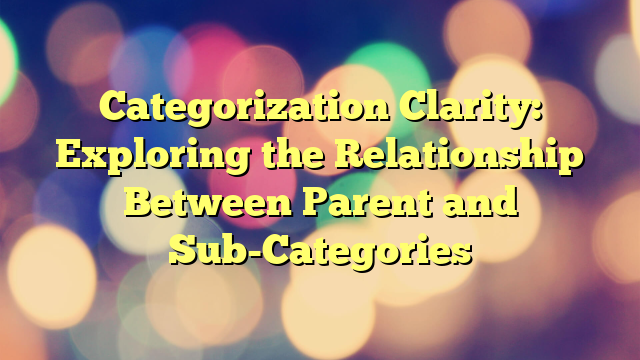Categorization Clarity: Exploring the Relationship Between Parent and Sub-Categories

Categorization is an essential aspect of organizing information and content in various fields, including e-commerce, web design, and digital marketing. Creating a clear and well-structured hierarchy of parent and sub-categories is crucial for providing a seamless user experience and improving search engine optimization (SEO) efforts. In this article, we will delve into the importance of categorization clarity and its impact on the relationship between parent and sub-categories.
Understanding Parent and Sub-Categories
Before we discuss the relationship between parent and sub-categories, let’s define these terms for better clarity.
Parent Categories: A parent category refers to the main or top-level category that encompasses a broader range of items or topics. It acts as an umbrella term that represents a general classification. For example, in an e-commerce website specializing in fashion, the parent category could be “Clothing.”
Sub-Categories: Sub-categories are nested under the parent category and provide more specific classifications within it. These sub-categories further narrow down the classification and help users find relevant information or products. Continuing with the fashion example, the sub-categories might include “Men’s Clothing,” “Women’s Clothing,” and “Children’s Clothing.”
Each of these sub-categories can further include more specific options like “Shirts,” “Pants,” “Dresses,” and so forth.
The Importance of Categorization Clarity
Categorization clarity plays a crucial role in enhancing the overall user experience and improving SEO efforts. Let’s explore the key benefits:
-
Enhanced User Experience: A clear and well-structured categorization system ensures that users can easily find the information or products they are looking for. By providing intuitive navigation and logical grouping of items, the user experience is greatly enhanced. This leads to increased customer satisfaction and engagement, as users can quickly locate what they need without any confusion.
-
Improved SEO: Search engines like Google value well-structured websites with clear categorization. By organizing content hierarchically, you make it easier for search engine crawlers to understand your website’s structure and index it properly. This, in turn, can positively impact your search rankings and visibility. When search engines can easily interpret your website’s categorization, it becomes more likely for your content to appear in relevant search results.
-
Better Conversion Rates: When users can easily navigate through your website and find what they need, it increases the likelihood of conversions. By offering a clear hierarchy of parent and sub-categories, you guide users towards relevant products or information, improving conversion rates and overall sales. When users can quickly locate products or information that align with their needs, they are more likely to make a purchase or take a desired action.
Establishing a Strong Relationship Between Parent and Sub-Categories
To ensure categorization clarity and strengthen the relationship between parent and sub-categories, consider the following best practices:
1. Conduct Thorough Research and Analysis
Before creating or modifying your categorization structure, conduct comprehensive research to understand your target audience, their preferences, and search behavior. Analyze your industry’s existing categorization practices and competitor websites to gain insights and identify opportunities for improvement. By understanding what your audience expects and how they navigate through similar platforms, you can design a categorization structure that meets their needs effectively.
2. Think User-Centric
Always prioritize the needs and expectations of your users when designing your categorization structure. Put yourself in their shoes and think about how they would navigate through your website. Consider what categories or sub-categories would make the most sense to them. Avoid using jargon or complex terms that might confuse your users, and opt for intuitive and user-centric labels instead. By using language that resonates with your audience, you can ensure a seamless browsing experience.
3. Keep It Simple and Intuitive
Simplicity is key when it comes to categorization. Aim for a concise and straightforward structure that users can easily comprehend. Avoid creating too many levels of sub-categories as it can overwhelm users and make navigation cumbersome. Instead, focus on creating broad parent categories with specific and relevant sub-categories. This approach allows users to quickly locate their desired information or products without getting lost in a complex web of categories.
4. Use Descriptive and Keyword-Rich Labels
When naming your parent and sub-categories, use descriptive labels that clearly indicate the contents within. This helps users understand what they can expect to find within each category. Additionally, optimize your category names with relevant keywords to improve SEO and ensure better visibility in search engine results. However, it’s important to strike a balance and make sure the labels remain user-friendly and natural. Avoid excessive keyword stuffing, as it can negatively impact the user experience.
5. Provide Clear Navigation and Visual Cues
In addition to well-labeled categories, it is essential to provide clear navigation menus and visual cues to guide users through your website. Implement breadcrumbs, search filters, and sorting options to help users refine their search and find what they need quickly. Clear calls-to-action and links to related categories also contribute to a seamless user experience. By providing intuitive navigation tools, you make it easier for users to explore your website and discover relevant content.
6. Regularly Review and Update
Categorization is not a one-time task; it requires ongoing maintenance and optimization. Regularly review your categorization structure, analyze user behavior, and make necessary updates based on user feedback and changing trends. This iterative process ensures that your categorization remains relevant and effective in meeting user expectations. By staying proactive and adapting to evolving user needs, you can continuously improve your categorization system and provide an optimal user experience.
By implementing these best practices, you can establish a strong relationship between parent and sub-categories, ensuring categorization clarity and a seamless user experience. Remember, an intuitive and well-structured categorization system not only enhances user satisfaction but also contributes to improved SEO and higher conversion rates.
